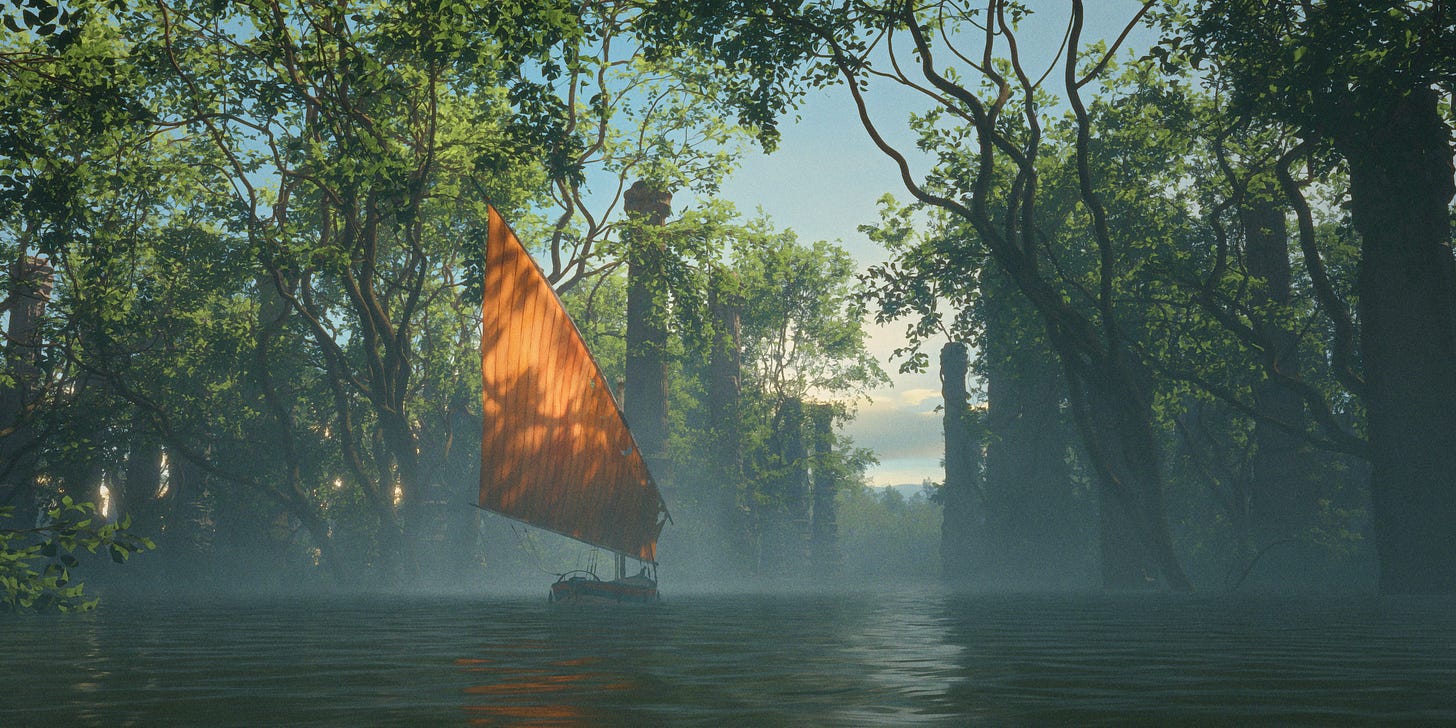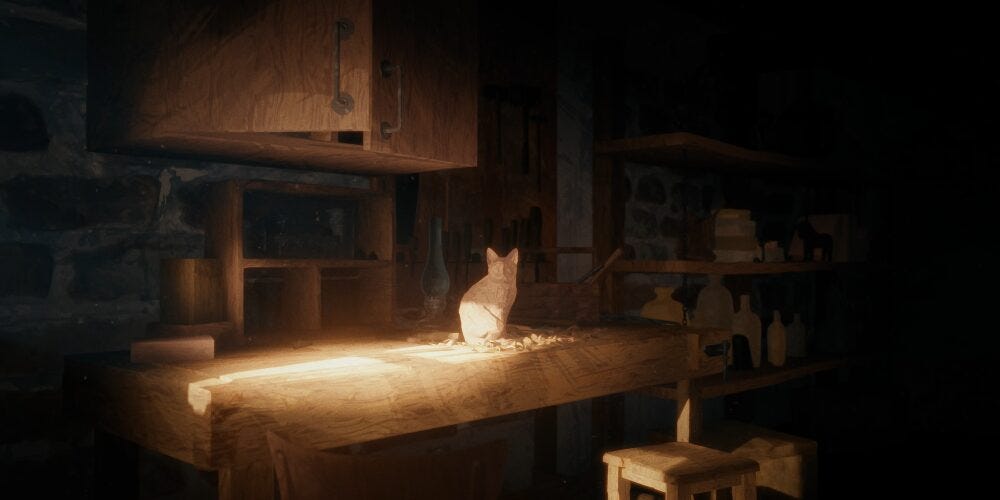This week Clint and I watched the French indie animation Flow. I didn’t know much about it, but had seen the poster a few times on social. Then, Letterboxd posted their highest rated films of the year lists and it was on the animation list. I love cats, so maybe that’s simply the reason I was pulled toward this film. Or maybe it was something more magical, more subtle.
This week’s full moon left me feeling isolated, ignoring my needs, and feeling a dense cluster of waterworks behind my eyes that I couldn’t seem to release. On Wednesday I was at my coldest, and this movie was calling. I listened, and after dinner Clint and I cozied on the couch and dove in.
I’ll note that the idea came to me to review this film in my own little Easily Overwhelmed way while at WriteShop—a very sweet writer gathering I attend at draft creative space hosted by Lauren. Out of character for me, I complained about the snow when we sat down. Rather than feeding into my annoyance, Lauren gently urged me, with her hand on my arm, to sit with that. She noted that her plants outside are enjoying it from underground. I hadn’t thought about that. I suppose a layer of snow is cold, yes, but the plants are hibernating and dormant and the snow probably sends them a load of hydration. Honestly, how dare I criticize the snow?
It isn’t the snow so much that I find myself so adverse to, but how obvious it makes our pollution. I really can’t be one to complain, because I drive a big, stinking car daily. I just get a little annoyed every time I get a belly-full of exhaust. The streets are lined with black-dust-covered ice, eventually seeping into into the earth. It’s disgusting. Our society doesn’t allow for easy and simple ways of taking care of our home. Either way, I am forming this cynical opinion about the snow, as if it adds to or changes anything about the circumstances. Not helpful.
At WriteShop, I journaled on Lauren’s official prompt, which was the information that birds fly in a “V” formation, so that each bird can catch wind and expend less energy in flight. Each bird rotates, taking on the lead position with the most resistance, knowing eventually they will get rest. They don’t argue or complain about this, they simply respond to what they inherently know. The prompt suggested that we think about this in terms of our own community as humans. So I wrote about nature and, because the film so beautifully touches on inherent knowing, Flow.
All nature is designed to work together. Not because it’s easy, feels good, or gives bragging rights, but because it is necessary to the survival of all species. The birds work together because it ensures their health and survival. Nature responds to what nature presents. Snow on the ground? The plants and animals make do. No snow on the ground? The plants and animals make do.
This is the premise of Flow. We follow a black cat with big, bright, yellow eyes through a catastrophic event. A flood destroys the setting that we became so enamored with in the first few scenes of the movie—the magical light, the curious cat sculptures, and the portrayal, somehow, of ether. The animation is beautiful in a quirky, different, videogame-esque way. Even if at first glance not as crisp and clean as a Studio Ghibli or Pixar animation, the design is nonetheless captivating and serene. There is no spoken dialogue in this story. But the director, Gints Zilbalodis, and co-writer, Matiss Kaza, clearly understand how, if we are in tune with it, our subtle energies are enough to communicate and exist with each other. We have the gift of words, but when we understand how to let go of the intellect, we really don’t need them to understand.
Of course my day unraveled with these themes even further in Kundalini yoga. I was late and missed the first ten minutes when Jai usually speaks on the purpose of the kriyā (or practice) that we do, but throughout the hour I gathered that we were working with both diaphragmatic breath and discriminative discernment. Jai explained that the Yoga Sutras suggests that there are three ways we accept things as true:
1. Anumana, or intellectual knowledge, which is what you can think about and reach a seemingly logical conclusion
2. Agama, or devotional knowledge, which is the knowledge you don’t understand but you take it to be true because you trust the source
3. Pramana, or experiential knowledge, is direct experience, and when we experience something we know it to be true even if we don’t understand it logically
Pramana is what we’re talking about here. Kundalini is a way to directly experience the energetic body. It’s often described as a sparkly or tingly feeling. It’s feeling into the energetic channels that weave through the 99.99% of empty space that we, and all matter, are. There is so much value in trusting in the things we know without needing to intellectualize or put words to them.
Flow, I think, represents this direct experience through magical realism. Magical realism seems to be a genre that captures the subtle, or the energetic body. It’s a beautiful genre, eloquently showing how magic isn’t so different from reality. What’s happening on screen isn’t so different from life if we are willing to shift our perspective from an information-heavy society. The characters in Flow are blatantly what they are. The cat is curious and selfish. The capybara is lazy and unconcerned. The bird is regal and stubborn. The lemur is playful and attached. The dog is floppy and excited. The artists who worked on this animation did a stellar job of conveying energy and emotion through the body language and expected mannerisms each of these animals truly embodies. They convey so simply that we all see each other. The cat mimics the bird’s posture, the dog catches the cat playing. This film is empathetic, simple, and calming at its deepest. It’s silly, relatable, and sad at its surface.
The unlikely team sails aboard an abandoned boat to wherever it flows. Always responding to whatever happens—whether that’s a treacherous thunderstorm or learning to swim better. The cat falls off the boat? They figure it out. The bird gets abandoned by its flock? They move on. As a little community, they figure it out without having any idea where each decision may take them or what it all means. This isn’t to say they don’t have emotions, it’s quite the opposite—they accept the effects, feel them, and keep flowing. Each animal helped when it was their turn, like the birds do in their “V” formation.
While the themes range from community to catastrophe, there is one motif in the film that I’ve been coming back to. In the beginning, we see the cat looking into their own reflection in a stream of water. Throughout the movie, just every so often, they’ll find themselves looking into their own reflection at various points of the adventure. The cat notices the others’ eyes too. A mirror happens to be on the boat they are using as home. The cat is interested. The lemur finds comfort, maybe a little too much, in looking into their own eyes. The capybara doesn’t seem to notice it. It’s a relic of a time we are left unclear on.
Throughout the story, we are reminded that these animals can see—themselves, each other, what is happening around them. It seems simple, but the way they wove this idea in has left me contemplative. The cat looks at their reflection and seems to think, “I have eyes that see, and so do the others.” My cat, Toulouse, can see me. She responds to me based on my body language and what I’m doing. When I start getting my coat on and packing my bag, she sits properly on the kitchen mat with an annoyed but accepting glare. I see her, she sees me. She literally sees me, but she also knows from direct experience what is going to happen next—another kind of seeing. Is this kind of communication worth any less or more than intellectualizing together with words as humans?
The ending is a moving display of how we each thrive in different environments. A large, magical, whale-like animal that was once sifting easily through the water that destroyed the cat’s home is now gasping for their last breaths on the soft grass. The courageous cat runs over to the animal that once terrified them, and understands there is nothing savior-like to be done for them like the past few scenes had shown. The thing to be done is providing comfort, and the whale-like creature blinks at the cat, seeing them, with the most radiant and sparkling eyeball—energetically saying, “I am glad you are here.” The cat understands, and rubs their head against the whale for the final moments, and isn’t that, also, being the leading bird?
Remember that well of tears ready to burst I mentioned earlier? I got that release with this film. It felt so good. It reminded me of color, of responding to what life presents us because that’s just what we do, and most importantly, the value of simply seeing. There’s this narrative, especially surrounding spiritual learning, that people need to “open their eyes.” After watching this movie, I think I’ve changed my mind that people need to open their eyes. All of our eyes are open, literally and figuratively—but some of us are just pretending we can’t see.
See, my friends, feel.







